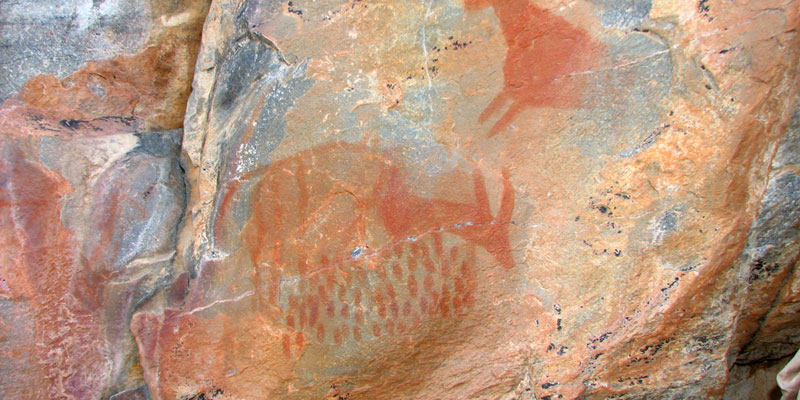
Tsodilo Hills
Hill range with thousands of rock paintings
Tsodilo Hills is a range of hills with of the highest concentrations of rock paintings worldwide. As these paintings are extremely unique Tsodilo Hills was proclaimed as UNESCO World Heritage Site in 2001.
At the edge of the north-western Kalahari in the Ngamiland district, four quarzite hills form one of the highest elevations in Botswana surrounded by endless savannas. On an area of 10 km² one of the highest concentrations of rock paintings in the world is found at Tsodilo Hills. More than 4500 rock paintings were found here during scientific researches. Thus, Tsodilo Hills is also called the “Louvre of the desert”.
Specifications
Rock paintings
Legends about Tsodilo Hills
In the language of the original inhabitants Tsodilo means “the rock that whispers”. The Tsodilo Hills are made up of 4 mountains or rather hills (Botswana is situated on an high plateau with an average height of 1000 metres above sea level, thus the approx. 400 m high outcrops are seen as hills and not mountains): The highest hill with 410 m carries the name “The Male”. The second largest hill with 300 m is called “The Female”. The third hill, which is 2 kilometres away and only 40 m high is called “The Child”. Only the fourth hill does not have a name. According to the San legend the fourth hill symbolises the first wife of the Male, whom he left for a younger one.
The San Bushmen regard the Tsodilo Hills as a holy place, where the spirits of their ancestors are resting. Their gods still live within the female hills, from where they control the world. The most holy place for the San is situated just beneath the summit of „The Male”, where according to legend the very first spirit prayed. The San believe that killing or hunting in the vicinity of the hills will bring great misfortune. Many legends tell about those who defied the rule and were stuck by misfortune.
The Hambukushu tribe, also living in the area believes that the hills mark the spot where God released humans onto the earth.
The formation of the Tsodilo Hills
Geological research revealed that the rock formations of the Tsodilo Hills are about a billion years old. Archeological studies show that the area has been inhabited by humans since 25.000 to 30.000 years ago by hunter-gatherers, most probably Bushmen. Findings of harpoons and angling hooks suggest that living conditions in the dry Kalahari must have been more friendly back then.
The rock paintings seem to originate from this period as well. Fact is that they are at least 10.000 to 20.0000 years old. Most paintings are found in the vicinity of The Female. Interesting enough a group of scientists did a closer study on the paintings in 1994. Of altogether 600 painting sites 51% depict animals, 35% geometric symbols, 12% humans and 2% hand prints.
Infrastructure/Tourism
Although the road from Shakawe (approx. 50 km) is a good dirt road there are some sandy stretches between the hills, so travelling by 4x4 is advisable.
In 2001 a museum has been established, which informs about the history of the Tsodilo Hills. Here the entrance fees are paid and the local guides await guests to take them around the hills to the most impressive sites. Guests should be respectful as the Tsodilo Hills are a sacred site for the people living there.
At the entrance a community campsite with sanitary facilities is available for camping guests. Up until 2013 five wild campsites without any facilities were available, but have been closed. Should you would like to camp in the wild away from the main campsite, please communicate with the museum (and still pay the community camping fee).
Although the Tsodilo Hills are open for visitors all year round, the best time to travel is between April and October, as it gets extremely hot during the rest of the year.








